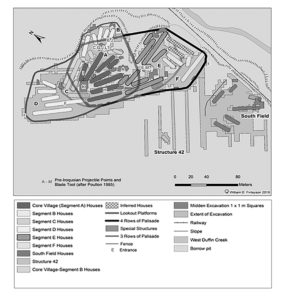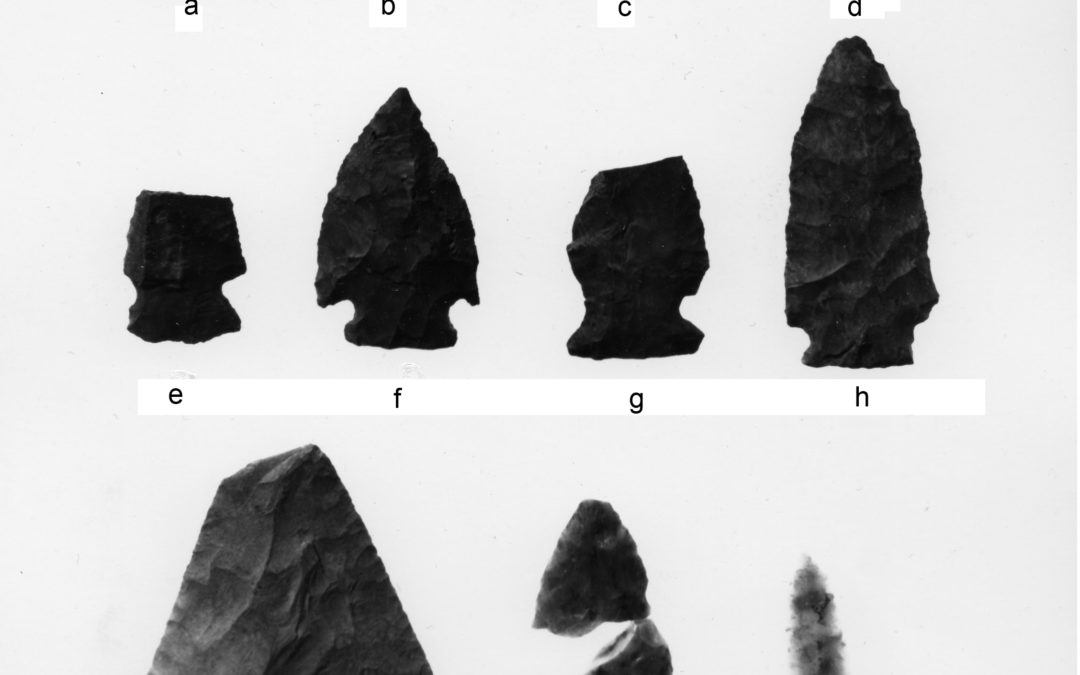I ended last month’s post with this statement “One never knows what unusual artifacts are to be found in the collections at sites such as Draper and what new insights will result from their study.”
Fittingly, I continue with another extraordinary set of findings we recovered from our excavations at the Draper site in 1975 and 1978. This involves 10 projectile points which predate the occupation of the Draper Village by many centuries. Indeed, one of these projectile points may be 8,000 to 8,900 years old, while some are several millennia old.
First let me clarify what I mean by projectile points. In our study of archaeological sites across southern Ontario we find a range of projectile points of different sizes and shapes, and made from different kinds of stone, mainly chert. Some of the early projectile points were made to be hafted to spears (hafting is a process by which a bone, metal, or stone projectile point is attached to the shaft of a spear) used to throw by hand. In other cases, the projectile points were attached to shafts which were set on a spear-thrower that acted as an extension of the arm of the thrower to add additional thrust to the shaft being thrown. Finally, the bow and arrow were introduced about 3,000 years ago, resulting in smaller projectile points which we call arrow points.

Figure 1 – Map of Pre-Iroquoian Projectile Points and Blade Tool from the Draper Site
The 10 projectile points from Draper are illustrated in Plate 1 above (see main image of post), and their distribution is illustrated in Figure 1 here.
One explanation for the presence of these points may be that pre-Iroquoian peoples lived where the Draper site was located centuries before Draper was occupied by Iroquoian people. However, this seems highly unlikely since our surveys of the Pickering Airport Lands determined that there was very little occupation of these lands prior to about A.D. 1300.
The second explanation for these early projectile points is that some of the occupants of the Draper site were simply collecting them. It is true that various points could have been unearthed in their agricultural fields and others may have been obtained in trade. Regardless, our belief is that these artifacts were found at Draper because certain occupants of the site were amassing them, perhaps as good luck charms or for other purposes which we do not understand.
Support for this interpretation is gained by the fact that most of these artifacts were found in the northeastern part of Segment A and the adjacent part of Segment B of the Draper site as illustrated in Figure 1.
Once again, an intriguing problem, one that can only be solved by looking at the distribution of these early projectile points at other Iroquoian sites in southern Ontario.
And so, our work continues.
Given these incredibly unique times, many are more home-bound than usual. As a result, some of us are catching up on our reading list among other things. Are you? If so, and you’re interested in learning more about 19th century archaeology in Ontario, the three popular books in Our Lands Speak series, along with the first occasional paper, are truly fascinating reads. All are available in high quality, full colour publications and digital formats for your consideration.
Stay safe and well.
Sincerely,
Bill
William D. Finlayson, Midland, Ontario
Ontario’s Leading and Senior-Most Archaeologist and Author
Founder of Our Lands Speak Book Series and Occasional Papers in Ontario Archaeology
Feature image: Plate 1, Pre-Iroquoian artifacts
All rights reserved. The use of any part of this publication reproduced, transmitted in any form or by any means, electronic, mechanical, photocopying, recording, or otherwise, or stored in a retrieval system, without the prior written consent of the author and publisher is an infringement of the copyright law. To that end, every attempt has been made to give proper acknowledgement, and access appropriate permissions for quotes. Any oversights are purely unintentional. In the unlikely event something has been missed, please accept our regret and apology, and contact us immediately so we can investigate and rectify as needed. All of the quantitative factual information is recorded in various published and unpublished sources and can be provided upon request.
